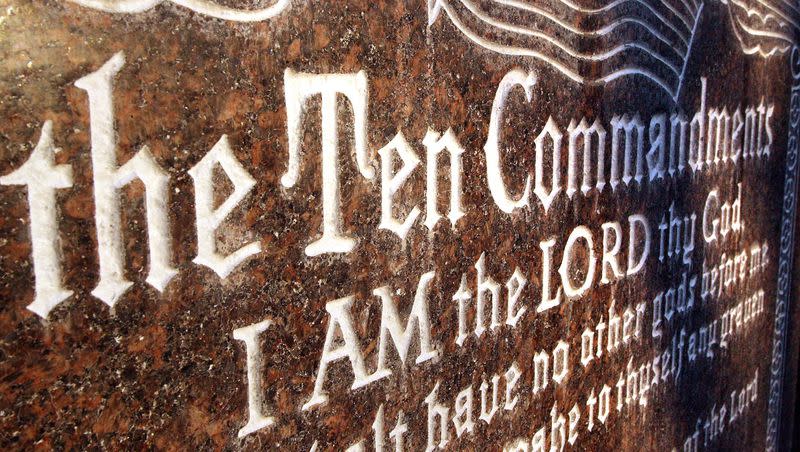Opinion: Your questions about the ‘Ten Commandments bill,’ answered

- Oops!Something went wrong.Please try again later.
- Oops!Something went wrong.Please try again later.
Since the introduction of HB269 — the “Ten Commandments bill” — I have been peppered with questions from all sides. Why are you doing this? Haven’t you heard of the “separation of church and state”? Have you ever read the Constitution? How about the First Amendment? The answers to the last three are yes, yes and yes.
Why am I doing it? I am running HB269 to restore the Ten Commandments (also known as the “Decalogue”) to the stature they deserve in our society, taking their place within the canon of our greatest establishing documents and traditions as a cornerstone of American and Western civilization.
I fear our younger generations are losing a sense of our civic and spiritual history at a time when that sense could not be more vital. George Orwell said, “Who controls the past controls the future: who controls the present controls the past.” Orwell meant it as a warning; the modern Left consider it a how-to guide. If we do not educate following generations about the principles that built our nation, what hope is there to preserve them?
The Founders drew heavily on the timeless truths of the Bible, on Greek philosophy, British Common Law, the Magna Carta and other Western works. The Decalogue has had a profound and distinct impact on our emergence as a nation.
That said, the intent of the bill is not to impose religious studies in the public classroom. The point is to understand our foundation and development as a nation. While the Decalogue has religious significance for millions, HB269 is more about its formational role in Western thought, literature, history and jurisprudence. The intent is more the study of its effects on our culture, history and government than its religious significance.
Now, have I ever “heard of the ‘separation of church and state’”? I have. Not only that, I understand it.
Related
Despite popular misconception, “separation of church and state” is not found in any of our founding documents (i.e. U.S. Constitution, Declaration of Independence, etc.). Rather, it comes from a personal letter authored by President Thomas Jefferson on Jan. 1, 1802, to the Danbury Baptist Association in response to their earlier letter.
Over the past 50 years, the Left has completely inverted Jefferson’s actual meaning and context.
“To invert,” according to Webster, means “to reverse in position, order, or relationship.” What Jefferson meant in his letter to the Danbury Baptists was the exact inverse of what today’s Left claim he meant. He was assuring a particular group that the government, under the Constitution, would never prevent them from practicing their religion. It was a protection for the practice of religion, not a protection against its practice.
Just two days later, the so-called advocate for “separation,” Jefferson, attended a religious service held in the House of Representatives. An additional two federal buildings were designated for church services under his watch.
The 1960s and ’70s were a time of protest, upheaval and secularization. Traditional American values were under constant attack. Perhaps reactively, the Supreme Court took to issuing novel rulings narrowing the public practice of many religious expressions. It was an unwarranted consolidation of power under the aegis of the central government at the expense of the states.
In 1971, the court established the “Lemon Test,” delineating what constituted acceptable religious activity in the public sphere. That court presumed that public sentiment should override First Amendment assurances of religious freedom.
To coin a phrase, what was intended as a shield came to be used as a sword. The First Amendment was intended as a shield for religious practices, not as a sword to destroy them. Earlier courts seemed bent on eliminating all religious practice from the public square, which was never the intent of the Founders.
In recent years, the Supreme Court has set about restoring original constitutional order with an obvious pullback from the interpretations of the Warren and Burger courts. The Roberts court has demonstrated its willingness to reexamine the forced secularization of public properties.
The current court understands that it was never the intent of the Founders to exclude religion from the public square. With two rulings in 2022, the Roberts court finally laid the Lemon Test to rest.
Some say that the free exercise clause is in conflict with the establishment clause. I disagree. No one these days is contemplating the establishment of a state religion. But neither should we tolerate the establishment of, to again coin a phrase, a state “anti-religion.”
I know this will aggravate critics, but Ronald Reagan once said, “If we ever forget that we’re one nation under God, then we will be one nation gone under.” How can we find our way forward if we do not understand what came before? HB269 is a step in the right direction.
Mike Petersen is a member of the Utah House of Representatives representing District 2.

